#environmental conservancy
Explore tagged Tumblr posts
Text
#!!!!!#great white shark#sharks#shark pups#good news#environmentalism#science#environment#nature#animals#conservation#nyc#new york#new york city#usa#ocean life#marine life#sea life
31K notes
·
View notes
Text
"In one of Africa’s last great wildernesses, a remarkable thing has happened—the scimitar-horned oryx, once declared extinct in the wild, is now classified only as endangered.
It’s the first time the International Union for the Conservation of Nature (IUCN), the world’s largest conservation organization, has ever moved a species on its Red List from ‘Extinct in the Wild’ to ‘Endangered.’
The recovery was down to the conservation work of zoos around the world, but also from game breeders in the Texas hill country, who kept the oryx alive while the governments of Abu Dhabi and Chad worked together on a reintroduction program.
Chad... ranks second-lowest on the UN Development Index. Nevertheless, it is within this North African country that can be found the Ouadi Rimé-Ouadi Achim Faunal Reserve, a piece of protected desert and savannah the size of Scotland—around 30,000 square miles, or 10 times the size of Yellowstone.
At a workshop in Chad’s capital of N’Djamena, in 2012, Environment Abu Dhabi, the government of Chad, the Sahara Conservation Fund, and the Zoological Society of London, all secured the support of local landowners and nomadic herders for the reintroduction of the scimitar-horned oryx to the reserve.
Environment Abu Dhabi started the project, assembling captive animals from zoos and private collections the world over to ensure genetic diversity. In March 2016, the first 21 animals from this “world herd” were released over time into a fenced-off part of the reserve where they could acclimatize. Ranging over 30 miles, one female gave birth—the first oryx born into its once-native habitat in over three decades.
In late January 2017, 14 more animals were flown to the reserve in Chad from Abu Dhabi.
In 2022, the rewilded species was officially assessed by the IUCN’s Red List, and determined them to be just ‘Endangered,’ and not ‘Critically Endangered,’ with a population of between 140 and 160 individuals that was increasing, not decreasing.
It’s a tremendous achievement of international scientific and governmental collaboration and a sign that zoological efforts to breed endangered and even extinct animals in captivity can truly work if suitable habitat remains for them to return to."
-via Good News Network, December 13, 2023
#chad#abu dhabi#north africa#rewilding#endangered species#conservation#zoology#conservation biology#oryx#good news#hope#texas#big game#animals#endangered#environmentalism#environmental science#zoo#zoos#zoo animals
24K notes
·
View notes
Text
Good news for conservation

Youth leader Maya Tilousi shakes hands with Joe Biden on the day he signed a proclamation establishing the Baaj Nwaavjo I’tah Kukveni – Ancestral Footprints of the Grand Canyon National Monument, at the Historic Red Butte Airfied in Tusayan, Arizona.
About 41 million acres, an area slightly larger than Florida, has been placed under new protection across public and private lands during Biden’s term, meaning about 13% of the US landmass is now protected from corporate exploitation.
The White House has a goal to conserve 30% of US land and water by 2030.
10K notes
·
View notes
Text
Under what legal experts called a “historic” settlement, announced on Thursday, Hawaii officials will release a roadmap “to fully decarbonize the state’s transportation systems, taking all actions necessary to achieve zero emissions no later than 2045 for ground transportation, sea and inter-island air transportation”, Andrea Rodgers, one of the attorneys representing the plaintiffs in the case, said at a press conference with the governor.
#climate change#global warming#good news#hope#hopepunk#ecoanxiety#environmental grief#climate anxiety#climate grief#environment#fossil fuels#decarbonization#indigenous activism#positivity#climate hope#news#politics#activism#conservation
7K notes
·
View notes
Text
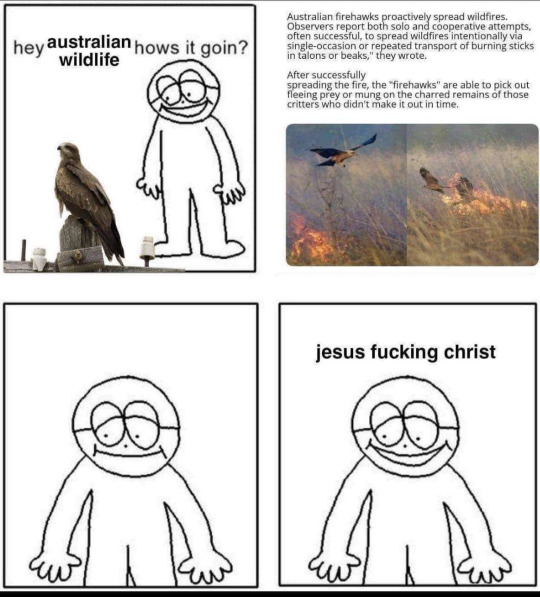
#green memes for ecological fiends#zoology#ecology#bird#hawks#environmental science#biodiversity#conservation biology#conservation#wildlife
29K notes
·
View notes
Text
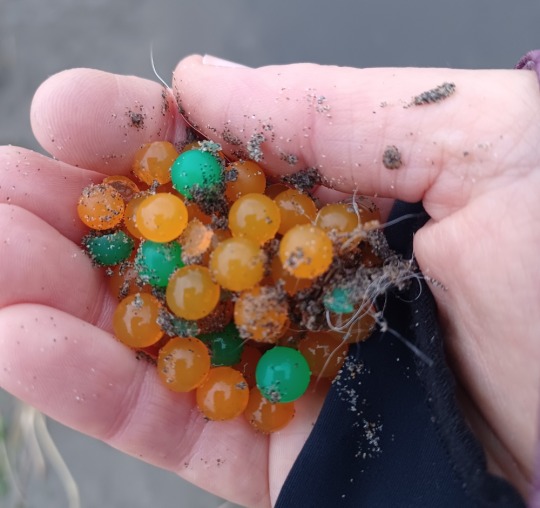
Welcome to my Tuesday morning PSA about plastics!
So--I was walking along the Bolstadt beach approach sidewalk here in Long Beach, WA yesterday afternoon, and I started seeing these little orange pellets on the ground that looked a little bit like salmon roe (but probably weren't). So I picked one up, and it was most definitely rubber. I went around picking up every one I could find, and while I didn't keep exact count I probably amassed 50-60 of them. I took this picture before depositing them in the nearest trash can.
These are airsoft gun pellets, and you can buy them in big jars containing thousands of them. That means that someone who decided that the beach was a great place to shoot their airsoft guns could easily litter the place with countless little bits of plastic rubber in less than an hour. We already have a huge problem here with people leaving trash, including tiny bits of plastic, all over the beach (you should see the gigantic mess after 4th of July fireworks when thousands of people come in from out of town, blow things up, and then leave again without picking up after themselves.)
But these airsoft pellets have a particularly nasty side effect. You know how my first thought was "wow, those look kind of like salmon roe?" Well, we have a number of opportunistic omnivore birds like crows, ravens, and several species of gull that commonly scavenge on the beach, especially along the approaches because people often feed them there. If I can catch the resemblance of an orange airsoft pellet to a fish egg, then chances are there are wildlife that will assume they're edible.
Since birds don't chew their food, they probably won't notice that the taste or texture is wrong--it'll just go down the hatch. And since they can't digest the pellets, there's a good chance they might just build up in the bird's digestive system, especially if the bird eats a large number of them--say, fifty or sixty of them dropped on the ground along the same fifty foot stretch of sidewalk. The bird might die of starvation if there's not enough capacity for food in their stomach--or they might just die painfully of an impacted gut, and no way to get help for it. If the pellets end up washed into the ocean, you get the same issue with fish and other marine wildlife eating them, and then of course the pellets eventually breaking up into microplastic particles.
You can get biodegradable airsoft pellets; they appear to mainly be gray or white in color rather than bright screaming orange and green. But "biodegradable" doesn't mean "instantly dissolves the next time it rains." An Amazon listing for Aim Green biodegradable airsoft pellets advertise them as "Our biodegradable BBs are engineered to degrade only with long-term exposure to water and sun and will degrade 180 days after being used." That's half a year for them to be eaten by wildlife.
I don't know, y'all. That handful of carelessly dropped rubber pellets just encapsulates how much people don't factor in the rest of nature when making decisions, even on something that is purely for entertainment like an airsoft gun. We could have had a lot of the same technological advances we have today, but with much less environmental impact, if we had considered the long-term effects on both other people and other living beings, as well as our habitats. We could have found ways from the beginning to make these things in ways that benefited us but also mitigated any harm as much as possible. Instead we're now having to reverse-engineer things we've been using for decades, and sometimes--like the "biodegradable" airsoft pellets--they still have a significant negative impact.
But--at least there are people trying to do things better, thinking ahead instead of just on immediate profit. We're stuck in a heck of a mess here, figuratively and literally, and changing an entire system can't be done in a day. Maybe we can at least keep pushing for a cultural shift that emphasizes planning far into the future--if not the often-cited "seven generations ahead", then at least throughout the potential lifespan of a given product.
#plastics#microplastics#environment#environmentalism#conservation#nature#pollution#litter#birds#tw animal death#animal welfare#ecology#science#wildlife#animals#scicomm#pnw#airsoft#biodegradable#solarpunk
4K notes
·
View notes
Text

#pagan#witch#paganism#dark#neopagan#wiccan#gardening#ecofriendly#ecology#conservation#environment#environmentalism#biodiversity
2K notes
·
View notes
Text
On Friday, the Georgia EPD granted permits to Twin Pines to strip-mine three miles from Okefenokee Swamp. This will be a "demonstration mine" of 600 acres digging out titanium dioxide, staurolite, and zircon. I cannot state how disappointed I am in my own state's environmental department to approve something so damaging to our natural wetland. The Okefenokee is the largest blackwater swamp in North America and one of the most endangered rivers in America. Hopefully, John Ossoff will block it again as he did back in 2022.
If you are looking for ways to help go ahead and check out 100miles.org and Georgia River Network.
#environmentalism#okefenokee swamp#save the swamp#protect our wetlands#swamp conservation#swampcore#save our wetlands#strip mining
1K notes
·
View notes
Note
hi
what's this one cause I have questions

1; is it edible
2: fun facts about it
THAMK YOU
That is a flying gurnard (Dactylopterus volitans)!

To answer your first question, they are edible! They're steadily becoming a more popular food choice because they have a relatively low oil content.


The first thing you might notice about this species is their very large pectoral fins. It's believed that their primary use is to scare off predators. Often the fish rest on the seafloor with the large fins tucked in, only displaying them when threatened. Additionally, they have finger-like segments of their pectoral fins which they use to walk across the sea floor.
These fish can also make noises! Using their swim bladder and jaw, they can make a grunt-like sound believed be used to scare off predators or communicate with each other.
#marine biology#science#animal facts#wildlife#biology#marine life#animals#marine ecology#ocean#fun facts#fish#weird fish#fishblr#cool fish#marine ecosystem#marine animals#aquatic#sea creatures#sea life#environment#environmental science#ecology#conservation#environmentalism#flying gurnard#cool animals
486 notes
·
View notes
Text
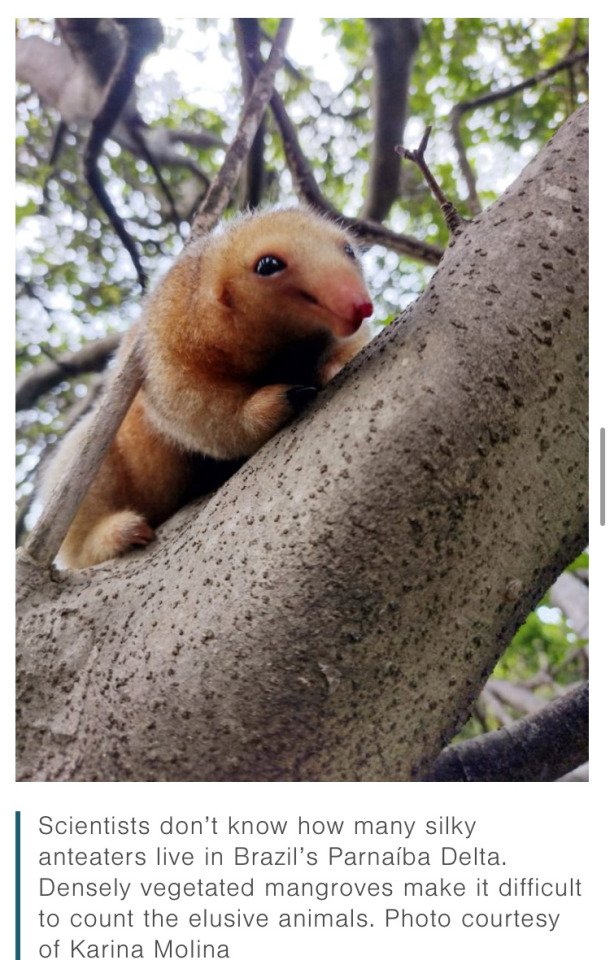
#anteaters#brazil#silky anteater#good news#nature#science#environmentalism#environment#animals#climate change#conservation#cute
12K notes
·
View notes
Text
No paywall version here.
"Two and a half years ago, when I was asked to help write the most authoritative report on climate change in the United States, I hesitated...
In the end, I said yes, but reluctantly. Frankly, I was sick of admonishing people about how bad things could get. Scientists have raised the alarm over and over again, and still the temperature rises. Extreme events like heat waves, floods and droughts are becoming more severe and frequent, exactly as we predicted they would. We were proved right. It didn’t seem to matter.
Our report, which was released on Tuesday, contains more dire warnings. There are plenty of new reasons for despair. Thanks to recent scientific advances, we can now link climate change to specific extreme weather disasters, and we have a better understanding of how the feedback loops in the climate system can make warming even worse. We can also now more confidently forecast catastrophic outcomes if global emissions continue on their current trajectory.
But to me, the most surprising new finding in the Fifth National Climate Assessment is this: There has been genuine progress, too.
I’m used to mind-boggling numbers, and there are many of them in this report. Human beings have put about 1.6 trillion tons of carbon in the atmosphere since the Industrial Revolution — more than the weight of every living thing on Earth combined. But as we wrote the report, I learned other, even more mind-boggling numbers. In the last decade, the cost of wind energy has declined by 70 percent and solar has declined 90 percent. Renewables now make up 80 percent of new electricity generation capacity. Our country’s greenhouse gas emissions are falling, even as our G.D.P. and population grow.
In the report, we were tasked with projecting future climate change. We showed what the United States would look like if the world warms by 2 degrees Celsius. It wasn’t a pretty picture: more heat waves, more uncomfortably hot nights, more downpours, more droughts. If greenhouse emissions continue to rise, we could reach that point in the next couple of decades. If they fall a little, maybe we can stave it off until the middle of the century. But our findings also offered a glimmer of hope: If emissions fall dramatically, as the report suggested they could, we may never reach 2 degrees Celsius at all.
For the first time in my career, I felt something strange: optimism.
And that simple realization was enough to convince me that releasing yet another climate report was worthwhile.
Something has changed in the United States, and not just the climate. State, local and tribal governments all around the country have begun to take action. Some politicians now actually campaign on climate change, instead of ignoring or lying about it. Congress passed federal climate legislation — something I’d long regarded as impossible — in 2022 as we turned in the first draft.
[Note: She's talking about the Inflation Reduction Act and the Infrastructure Act, which despite the names were the two biggest climate packages passed in US history. And their passage in mid 2022 was a big turning point: that's when, for the first time in decades, a lot of scientists started looking at the numbers - esp the ones that would come from the IRA's funding - and said "Wait, holy shit, we have an actual chance."]
And while the report stresses the urgency of limiting warming to prevent terrible risks, it has a new message, too: We can do this. We now know how to make the dramatic emissions cuts we’d need to limit warming, and it’s very possible to do this in a way that’s sustainable, healthy and fair.
The conversation has moved on, and the role of scientists has changed. We’re not just warning of danger anymore. We’re showing the way to safety.
I was wrong about those previous reports: They did matter, after all. While climate scientists were warning the world of disaster, a small army of scientists, engineers, policymakers and others were getting to work. These first responders have helped move us toward our climate goals. Our warnings did their job.
To limit global warming, we need many more people to get on board... We need to reach those who haven’t yet been moved by our warnings. I’m not talking about the fossil fuel industry here; nor do I particularly care about winning over the small but noisy group of committed climate deniers. But I believe we can reach the many people whose eyes glaze over when they hear yet another dire warning or see another report like the one we just published.
The reason is that now, we have a better story to tell. The evidence is clear: Responding to climate change will not only create a better world for our children and grandchildren, but it will also make the world better for us right now.
Eliminating the sources of greenhouse gas emissions will make our air and water cleaner, our economy stronger and our quality of life better. It could save hundreds of thousands or even millions of lives across the country through air quality benefits alone. Using land more wisely can both limit climate change and protect biodiversity. Climate change most strongly affects communities that get a raw deal in our society: people with low incomes, people of color, children and the elderly. And climate action can be an opportunity to redress legacies of racism, neglect and injustice.
I could still tell you scary stories about a future ravaged by climate change, and they’d be true, at least on the trajectory we’re currently on. But it’s also true that we have a once-in-human-history chance not only to prevent the worst effects but also to make the world better right now. It would be a shame to squander this opportunity. So I don’t just want to talk about the problems anymore. I want to talk about the solutions. Consider this your last warning from me."
-via New York Times. Opinion essay by leading climate scientist Kate Marvel. November 18, 2023.
#WE CAN DO THIS#I SO TRULY BELIEVE THAT WE CAN DO THIS#WE CAN SAVE OURSELVES AND THE WORLD ALONG WITH US#climate crisis#united states#climate change#conservation#hope posting#sustainability#climate news#climate action#climate emergency#fossil fuels#global warming#environmentalism#climate hope#solarpunk#climate optimism#climate policy#earth#science#climate science#meteorology#extreme weather#renewable energy#solar power#wind power#renewables#carbon emissions#climate justice
33K notes
·
View notes
Text

"hey how's it going"
#caring about environmental conservation and indigenous fauna and uh#mass transit#is antithetical to the leftist directives#???#marge have you ever actually read this thing
953 notes
·
View notes
Text

Citizens of the USSR are obliged to protect nature, conserve its natural wealth.
USSR Constitution, Article 67 poster (1979)
#poster#ussr#soviet#nature conservation#ecosocialism#communism#art#design#artist unknown#environmentalism
540 notes
·
View notes
Text
So, I saw a post circulating here about the “extinction of birds in 2023“, with this picture attached
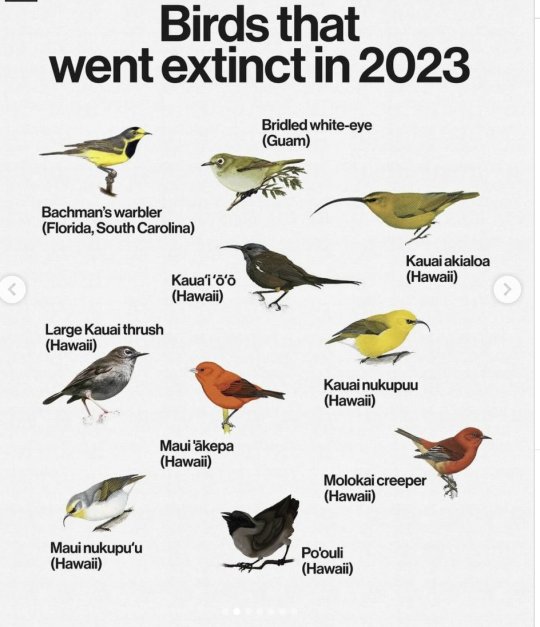
My, what a bold claim! All these poor birdies, “went extinct” in just one year alone? Why would such an outrageous, depressing and catchy claim be spread around? Let’s fact check it.
All the species listed, Bachman’s wabler (Vermivora bachmanii, 1988 or 1980s), Kāmaʻo or large Kauaʻi thrush (Myadestes myadestinus, 1989 or 1987), Bridled white-eye (Zosterops conspicillatus, 1983 and 1983), Kauai ʻakialoa (Akialoa stejnegeri, 1969 or 1960s), Kauaʻi ʻōʻō (Moho braccatus, 1987 and 1987), Kauaʻi nukupuʻu (Hemignathus hanapepe, 1899 and 1899), Maui ʻakepa (Loxops ochraceus, 1988 and 1988), Kākāwahie or Molokaʻi creeper (Paroreomyza flammea, 1963 and 1963), Maui nukupuʻu (Hemignathus affinis, 1896* and 1996 ) and Poʻouli (Melamprosops phaeosoma, 2004 and 2004) are all, indeed, either extinct or possibly extinct, according to IUCN Red List of Threatened Species and U.S. Fish and Wildlife Service.
What are the dates after the scientific names? Well, those all are *last sightings* per IUCN Red List and USFWS accordingly. So, these birds were not seen for DECADES and in one case FOR MORE THAN A GODDAMN CENTURY. And sure as hell there is NO information about them very suddenly being gone all last year.
What’s the deal then? Where did this claim even come from? Well, likely from this article "21 Species Delisted from the Endangered Species Act due to Extinction" from U.S. Fish & Wildlife Service. It includes all the birds in the picture (with the last date of sight, listed above).
From the article: “The U.S. Fish and Wildlife Service is delisting 21 species from the Endangered Species Act due to extinction. Based on rigorous reviews of the best available science for each of these species, the Service determined these species are extinct and should be removed from the list of species protected under the ESA. Most of these species were listed under the ESA in the 1970s and 80s and were in very low numbers or likely already extinct at the time of listing.”
They didn’t ALL fucking suddenly drop dead all in the same year – if they did, as some other people have already pointed out, there would be an uproar EVERYWHERE. Ornithologists alone would not let it live down. They were officially delisted from endangered status by U.S. Fish & Wildlife Service that year, there was a proposition to do so back in 2021, too. Some were already declared extinct before by IUCN.
Despite not being seen for so long, they remained on the list of critically endangered for a long while, cause you cannot just immediately declare a species extinct. There’s no RTS unit amount number that goes to 0 once there’s nothing left; people keep checking for them over and over and over again. Sometimes it turns out that a species previously thought to be extinct is actually still out there. Attenborough's long-beaked echidna for example was last sighted SIXTY YEARS ago before being sighted again in 2023. It was thought to be extinct for a while, before 2007, when signs of its activity was spotted again. More often than not though, a species turns out to be actually very extinct, unfortunately – like in this case. I cannot possibly know if the creators of this picture, or people that spread it on social media ever had good intentions behind it for awareness, however even if they did, it turned out to be nothing but very blatant misinformation, with a fearmongering effect. The only thing this achieves is not awareness of habitat destruction or pernicious tourist influence or climate change or what have you – the only thing this achieves is despair and panic. People already so casually fall into complete doomerism, they’re very used to hear bad news. And guess what doomerists do? Typically nothing. It renders people helpless. It’s not gonna make people get up and be ready for action, it, at best, would just make people feel sad and/or angry, or at worst, feed into the current alarming rise of ecofascism. NOTHING good comes out of this. At the very goddamn least, no one needs to lie to promote a goal.
The aim of the USFWS article, on the other hand, IS to make people aware about those animals that are already gone from the face of the planet, no matter how long ago, and that now we have to protect those animals that are critically endangered and still out there – to not have to repeat those tragedies.
Be very critical of what you see on the internet, especially if it’s sited with no sources. Especially-especially if it causes a strong emotional reaction. Lies and misinfo could only hurt the cause, no matter how noble. And please, be aware of your local wildlife status. Check in with it accoding to trusted sources.
[*sic, possibly a typo and it was meant to be 1996, other confirmed date listed there is 1989] Addendum: I could not for sure find the uncredided (who woulda thunken that ppl that don't cite their sources would also not credit the artists) author(s) of the bird illustrations. If someone finds them, please, let me know! Edit: Huge thanks to moosefinch for finding the sources for the artwork! I'll add their contribution below:
"Image sources!
The Kauai ʻakialoa, Kauaʻi ʻōʻō, Maui ʻakepa and Kauaʻi nukupuʻu are from Birds of the World.
The "Maui nukupuʻu" and "Molokaʻi creeper" illustrations are also Birds of the World, but are actually a female Kauaʻi nukupuʻu (the other being the male) and Laysan honeycreeper/Laysan ʻapapane respectively.
The bridled white-eye is by Lauren Helton according to this source.
Bachman's warbler is by Lynn Hawkinson Smith/smithhouse2 according to this Etsy listing.
The Poʻouli is by Christina Czajkowski."
#ah I just now see that the tumblr reblog of the pic and the twitter thread attached was deleted#yet the post is still in circulation. The damage lingers#so fucking irresponsible#fact check#misinformation#birds#bird#ecology#environmentalism#extinction#conservation#species conservation#animals#hawaiʻi#important
816 notes
·
View notes
Text
Christopher Brown’s ‘A Natural History of Empty Lots’
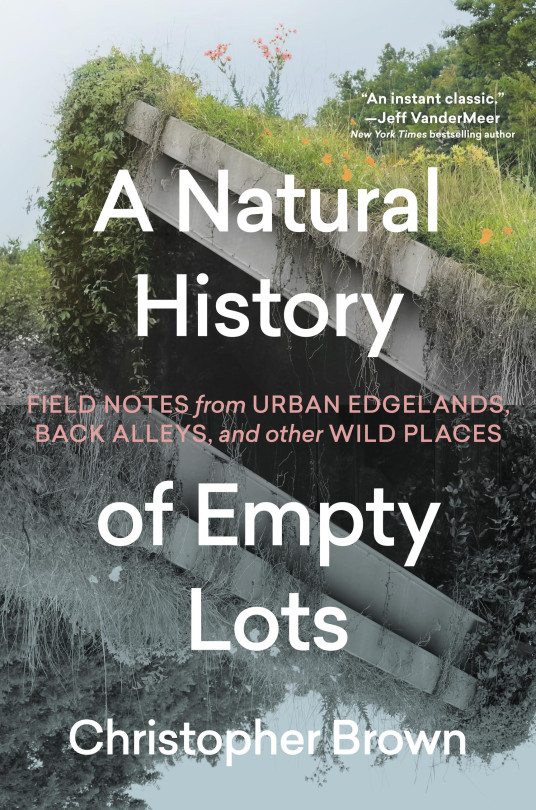
On SEPTEMBER 24th, I'll be speaking IN PERSON at the BOSTON PUBLIC LIBRARY!

Christopher Brown is an accomplished post-cyberpunk sf writer, a tech lawyer with a sideline in public interest environmental law, the proud owner of one of the most striking homes I have ever seen, and an urban pastoralist who writes about wildlife in ways I've never seen and can't get enough of:
https://fieldnotes.christopherbrown.com/
All of these facets of Brown's identity come together today with the launch of A Natural History of Empty Lots: Field Notes from Urban Edgelands, Back Alleys and other Wild Places:
https://christopherbrown.com/a-natural-history-of-empty-lots/
This is a frustratingly hard to summarize book, because it requires a lot of backstory and explanation, and one of the things that makes this book so! fucking! great! is how skillfully Brown weaves all that stuff into his telling. Which makes me feel self-conscious as I try to summarize things, because there's no way I'll do this as well as he did, but whatever, here goes.
Brown is a transplant from rural Iowa to Austin, where he set out to start a family, practice tech law during the dotcom boom, and write science fiction, as part of a circle of writers loosely associated with cyberpunk icon @brucesterling. After both the economy and his marriage collapsed, Brown started his restless perambulations around Austin's abandoned places, sacrifice zones, the bones of failed housing starts and abandoned dot-crash office parks.
When he did, something changed in him. Slowly, his eyes learned to see things that they had just skipped over. Plants, animals, and spoor and carapaces and dens of all description, all around him, a secret world. These were not pockets of "wilderness" in the city, but they were pockets of wildness. Birds' nests woven with plastic fibers scavenged from nearby industrial dumpsters; trees taking root in half-submerged tires rolled into a creekbed, foxes and rodents playing out a real-life version of the classic ecosystem simulation exercise on the edge of an elevated highway that fills the same function as the edge of a woodland where predator and prey meet.
As Brown fell in love again – with the artist and architect Agustina Rodriguez – he conceived of a genuinely weird and amazing plan to build a house. A very weird house, in a very weird place. He bought a plot of wasteland that had once housed the head-end of an oil pipeline (connected to a nearby oil-storage facility that poisoned the people who lived near it, in an act of wanton environmental racism) and had been used as a construction-waste dump for years.
After securing an extremely unlikely loan, Brown remediated the plot, excavating the oil pipeline, then building the most striking home you have ever seen in the resulting trench. Brown is a pal of mine, and this is where I stay when I'm in Austin, and I can promise you, the pictures don't do it justice:
https://www.texasmonthly.com/style/christopher-brown-edgeland-house-austin/
Formally, A Natural History of Empty Lots is a memoir that explains all of this. But not really. Like I say, this is just the back story. What Natural History really is, is a series of loosely connected essays that explains how everything fits together: colonial conquest, Brown's failed marriage, his experience as a lawyer learning property law, what he learned by mobilizing that learning to help his neighbors defend the pockets of wildness that refuse to budge.
It's an erudite book, skipping back through millennia of history, sidewise through the ecology of Texas, all while somehow serving as a kind of spotter's guide to the wild things you can see in Austin – and maybe, in your town – if you know how to look. It's a book about how people change the land, and how the land changes people. It is filled with pastoral writing that summons Kim Stanley Robinson by way of Thoreau, and it sometimes frames its philosophical points the way a cyberpunk writer would – like Neal Stephenson writing a cyberpunk trilogy that is also the story of Leibniz and Newton fighting over credit for inventing calculus:
https://memex.craphound.com/2004/11/20/neal-stephensons-system-of-the-world-concludes-the-baroque-trilogy/
Brown is a stupendous post-cyberpunk writer, and also a post-cyberpunk person, which I've known for sure since I happened upon him one morning, thoughtfully mowing his roof with a scythe:
https://www.flickr.com/photos/doctorow/46433979075/
You can get a sense of what that means in this lockdown-era joint presentation that Chris, Bruce Sterling and I did on "cyberpunk and post-cyberpunk":
https://archive.org/details/asl-cyberpunk
Brown is a spectacular novelist. His ecofascist civil war trilogy that opens with Tropic of Kansas got so much right about the politics of American demagoguery and was perfectly timed with the Trump presidency:
https://memex.craphound.com/2017/07/11/tropic-of-kansas-making-america-great-again-considered-harmful/
The sequel, Rule of Capture, uses the device of courtroom drama in a way that comes uncomfortably close to the Orwell/Kafka mashup that the authorities have created to deal with environmental protesters:
https://memex.craphound.com/2019/08/12/rule-of-capture-inside-the-martial-law-tribunals-that-will-come-when-climate-deniers-become-climate-looters-and-start-rendering-environmentalists-for-offshore-torture/
And the final volume, Failed State, is one of the most complicated complicated utopias you could ask for. This is what people mean by "thrilling conclusion":
https://pluralistic.net/2020/08/12/failed-state/#chris-brown
As brilliant as Brown is in fiction mode, his nonfiction is unclassifiably, unforgettably brilliant. A Natural History of Empty Lots is the kind of book that challenges how you feel about the crossroads we're at, the place you live, and the place you want to be.

The paperback edition of The Lost Cause, my nationally bestselling, hopeful solarpunk novel is out this month!

If you'd like an essay-formatted version of this post to read or share, here's a link to it on pluralistic.net, my surveillance-free, ad-free, tracker-free blog:
https://pluralistic.net/2024/09/17/cyberpunk-pastoralism/#time-to-mow-the-roof
#pluralistic#books#reviews#gift guide#pastoralism#environmentalism#ecology#cyberpunk#austin#texas#climate#christopher brown#conservation#urbanism#ecosocialism#architecture#environmental racism#writing
349 notes
·
View notes
Text
Why Feeding Wildlife is Dangerous
Originally posted on my blog at https://rebeccalexa.com/feeding-wildlife-dangerous/
Winter is here in the Northern Hemisphere, which means that wild animals of all sorts are falling back on cold weather adaptations that have evolved over countless generations. Some, like reptiles and amphibians, go into brumation or other hibernation-like states. Others have warm feathers or fur to insulate them as they go about their lives in chilly conditions. They may migrate around their territory in search of various food sources. Not all will survive these harsh months, which makes feeding wildlife to help them through the hard times a tempting idea.
Unfortunately, while this is a kind-hearted act born of good intentions, the impact is all too often harmful. Here are a few of the damaging, even deadly, effects of feeding wildlife.
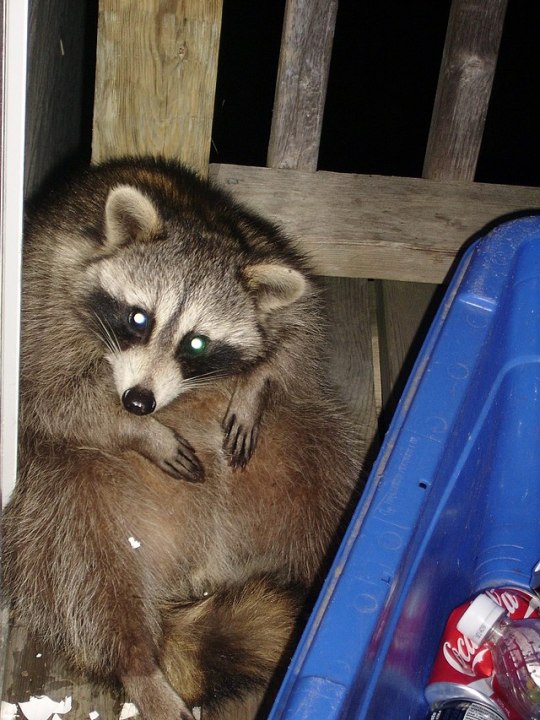
First, let’s be a little more nuanced about the definition of wildlife in this case. I support the feeding of birds, at least those that commonly visit bird feeders. These birds are of species that are used to their food sources–like seeds, berries, and insects–being temporary, and so they retain their ability to forage for food in various places. Also, because the birds are not being fed by hand, and tend to retain their natural fear of humans, they are not likely to become habituated to us. It should go without saying that trying to convince birds to eat from your hand, or otherwise stop being afraid of you, is a bad idea (more about that in a minute.) And, of course, you need to make sure to keep your feeders clean and watch your local birds very carefully for any signs of disease; here’s an article I wrote on feeding birds safely and ethically.
Wild mammals, on the other hand, have a tendency to become dependent on human sources of food much more readily than birds. If you leave food scraps, pet food, or trash out where they can access it, they quickly figure out that this is an easy meal, and will hang around more than birds might.
Some birds will be more easily habituated than others; ducks and geese, for example, will lose their fear of humans as quickly as mammals do, especially when being fed regularly at ponds or lakes. So consider this article to primarily cover wild mammals, waterfowl, and any other animal that can be easily habituated through feeding.

A good example of what NOT to do.
Habituation is the biggest behavior change seen in fed wildlife. A habituated animal is simply one that no longer fears humans, and sees us as a source of food handouts. Unlike normal, healthy wildlife, these animals do not run away when a human approaches, even at a close distance. As mentioned above, this means they may even become aggressive in seeking food, and people have been bitten, scratched, gored, or otherwise injured by habituated animals. It may be easy to see why a habituated bear or moose is dangerous, but even smaller animals like squirrels or raccoons have a very nasty, painful bite or scratch. Some also carry zoonotic diseases that can be passed to humans; rabies is the most notorious, but even a bacterial infection caused by the bite or scratch can be an unpleasant experience.
But this lack of fear isn’t just a threat to us. It also puts the wildlife at risk. Wild mammals that wander through our neighborhoods in search of food are more likely to be hit by cars, attacked by outdoor dogs or cats, and injured or killed by cruel humans. If hunting is allowed in the area, the animal may walk right up to a hunter. Plus wild animals that become a nuisance or threat to people are sometimes euthanized, as relocated animals often end up finding their way back to their original territory, or go find a new group of humans to mooch off of.
Feeding wildlife can also cause them to cease natural foraging behaviors. Not only does this mean they may starve if the humans in the area stop feeding them, but they don’t teach their young proper foraging either, and so you may have animals several generations down the line that no longer know how to find natural food sources in the area.
Also, what we're feeding wildlife can kill them.
So here’s the thing: humans are omnivores. Actually, we’re sort of super omnivores; we have one of the most varied diets of any species, especially now that we’re able to grow all sorts of domesticated crops, including but not limited to two dozen cultivars of wild mustard (Brassica oleracea), various and sundry grains, legumes, tubers, etc. And because we’ve spread all throughout the planet, we’ve successfully sampled thousands upon thousands of edible animals, plants, and fungi. We’ve managed to evolve tolerances to substances some plants produce to keep from being eaten, like caffeine and capsaicin, and some of us go out of our way to seek them. We’ve also heavily altered some of our foods through cooking, to include some methods that render the food quite unhealthy even for us (not that that stops us from eating it anyway.)
All of this means that over 300,00 years of existence, Homo sapiens has evolved the ability to eat a truly mind-boggling array of foods. Unfortunately, even the other omnivores in our lives can’t necessarily tolerate the foods we eat. Domestic dogs evolved alongside us, eating first our refuse, and then sharing our meals, for thousands of years. Yet they still can’t safely eat chocolate, avocado, onions, or grapes, and some things we’ve created like the artificial sweetener xylitol can also be harmful–even deadly–to dogs.
So when you put out a plate of table scraps for your local squirrels, opossums, raccoons, or even bears, there’s a very good chance that something there is going to make them sick. You could even be sentencing one of your visitors to death! Even if they don’t immediately get sick, over time eating the wrong foods could seriously affect the health of wildlife, and may lead to sickness and an earlier, unpleasant death.
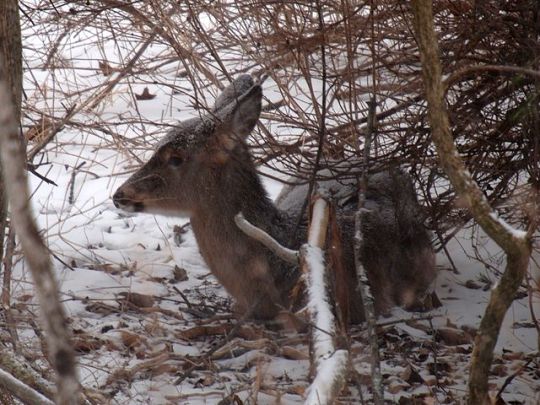
Sometimes, even something that seems like the “right” food can be deadly. Deer species in North America are adapted to eating lots of woody vegetation in winter; their gut microbiome is perfectly balanced to digest this tough food. However, some people like to feed them corn, either because they want to be nice, or because they want to hunt the deer. Unfortunately, the nutritional makeup of corn is very different from the deer’s winter fare. The carbohydrates in the corn can cause a condition called rumen acidosis. This overloading of carbs causes Streptococcus bacteria, which occur naturally in the deer’s chambered stomach, to overpopulate in a matter of hours. This raises the acidity of the stomach, and kills off many of the other microbes in the gut flora. This sudden imbalance essentially causes the stomach to stop digestion altogether. In a severe enough case, the deer dies a horribly painful death within twenty-four hours. Deer that survive often have permanently damaged stomachs, which can lead to worse health overall and a shortened lifespan.
Every ecosystem has adapted over thousands of years; in some cases, an ecosystem may be millions of years old (with some changes in species makeup, of course.) Over that time, species have evolved to keep each other’s numbers in check, whether through consuming each other, competing for resources, or spreading disease to other species as well as their own. One of the biggest limiting factors in a species’ habitat is the amount of food that’s available. You’ll generally have fewer large predators in a place than large herbivores, for example, because the land can support a lot more plants to feed herbivores than herbivores to feed carnivores.
So the ecosystem is able to keep its species in balance; any time a species begins to overpopulate, predation, starvation and disease tend to knock the numbers back. Some species even have “boom or bust” population cycles; lemmings, for example, are thought to have population fluctuations tied to the number of ermine preying on them in a given area.
But when we humans artificially change the availability of food in a given place, we can cause serious disruptions in these natural checks and balances. Put too much food in a place over time, and you end up with overpopulations of the animals that eat that food, with subsequent deaths from disease due to overcrowding, and starvation when the population inevitably outgrows even the artificially added food.
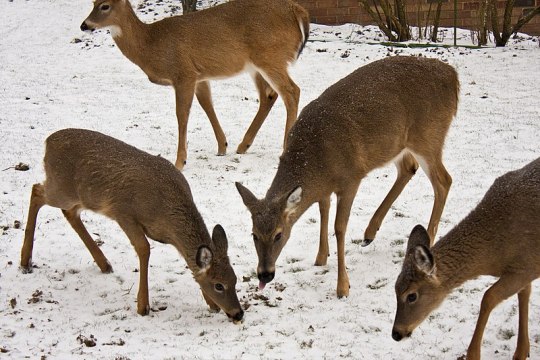
By John Davis, CCA-2.0
Speaking of disease, when feeding wildlife many people just dump the food in the same place every day or night, whether that’s pet bowls, a trash can, or a feeding site. This causes wildlife to congregate in unnaturally large numbers and on a regular basis, which again leads to increased disease transmission. Keep in mind that wildlife don’t have veterinarians they can just go to when sick, so you end up with wild animals dying some pretty slow, awful deaths due to these diseases. (And yes, this can happen with birds–again, why it is so incredibly important to properly clean your feeders regularly!)
I know it’s tempting to entice wildlife closer, and to want to help them through tough times. But it is incredibly important to keep a firm boundary between us and wild animals. We’ve already interfered in their lives and their behaviors enough. The more we meddle, the more harm we do to them, even if our intentions were good.
But wildlife are not pets. They are their own beings with their own lives and agendas, instincts and territories. They are, as Henry Beston wrote in The Outermost House, “not brethren, they are not underlings: they are other nations, caught with ourselves in the net of life and time, fellow prisoners of the splendour and travail of the earth.” And we respect them best when we give them their space and allow them to live as wild a life as possible in a world we have so dramatically changed.
If you want to create the best world for your local wildlife, create habitat and natural food sources for them. Remove invasive species, and plant more native plants, especially those that offer food and shelter to wildlife. (The native plant finder is a great starting point for those in the US.) Work to protect what wildlife habitat is left, especially habitats that are relatively undamaged like old-growth forests. This way you are helping to maintain space where these species can live the lives they have lived for many thousands of years without our interference.
Did you enjoy this post? Consider taking one of my online foraging and natural history classes, checking out my other articles, or picking up a paperback or ebook I’ve written! You can even buy me a coffee here!
#wildlife#nature#animals#wild animals#mammals#birds#winter#ecology#biology#zoology#naturecore#outdoors#animal behavior#nature literacy#long post#environment#environmentalism#conservation#science#scicomm
6K notes
·
View notes